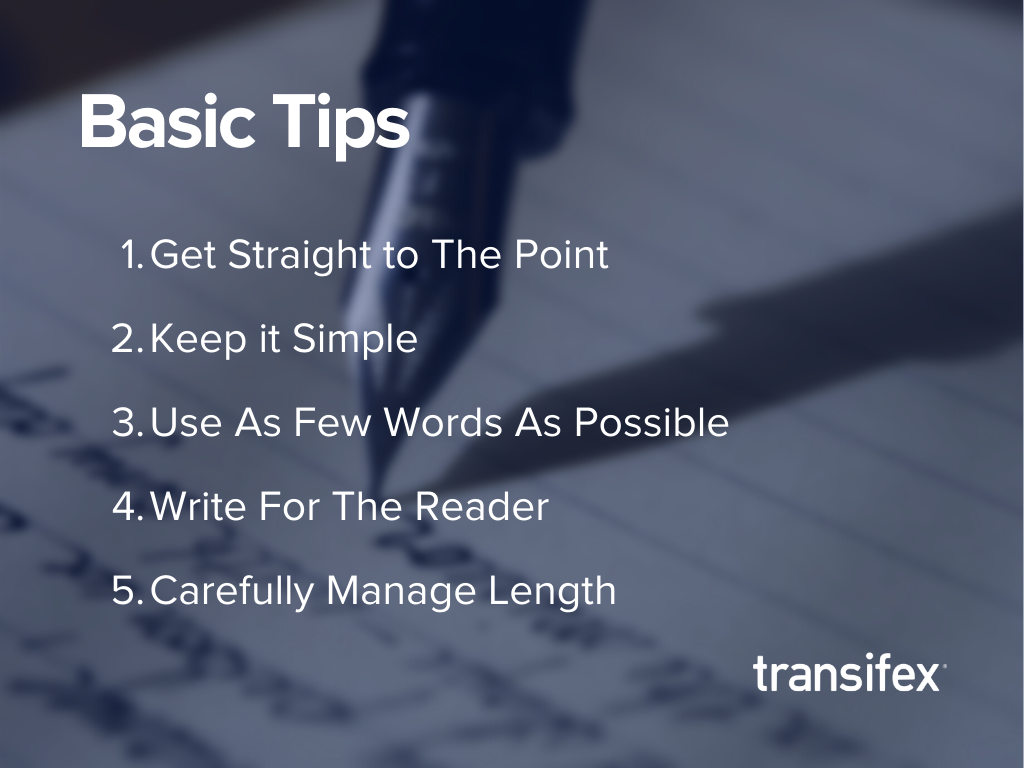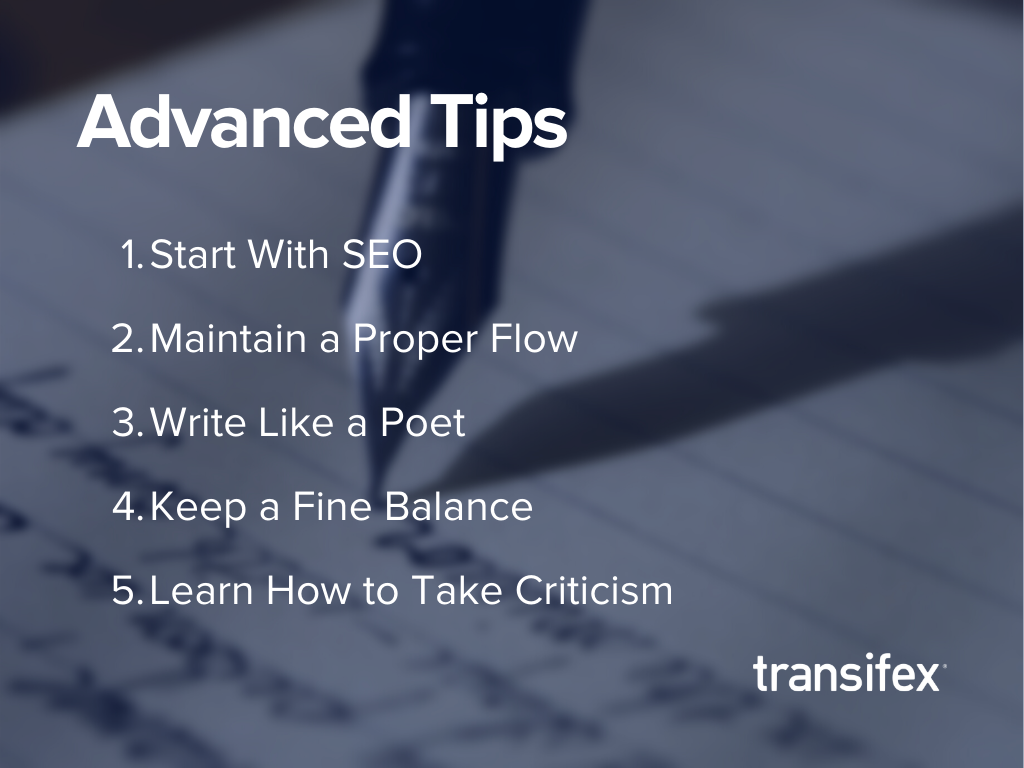Writing looks and sounds easy. Even kids can do it, right? But it’s not until you actually start writing professionally where you notice how tough it is – which is where professional writing tips can come in handy!
Here is how to deliver better web content for websites or blogs!
Top 10 Professional Writing Tips: Quick Start
What’s about to follow may be a bit too much to process for some. Many of you won’t even bother finishing this article.
People online don’t have the time and patience to kick back and read thousands of words – especially when they can find videos and other, more engaging types of content. And that’s something to always keep in mind when producing web copy.
There are ten (10) tips in total. Five basic tips for beginners and five more for more advanced writers who want to hone their craft.
The five basics:
- Get straight to the point
- Keep it simple with short sentences
- Complete your article with as few words as possible, but without sacrificing quality
- Write for the reader, not for you
- Carefully manage your post’s length. Keep the three triplets in mind. Up to 3 paragraphs intro and outro, 3 lines per paragraph, 300 words per heading
And the five advanced:
- Start and finish with SEO
- Maintain a proper flow
- Write like a poet
- Keep a balance between simplicity and poetry
- Learn how to take criticism
This is where the real tips begin!
Top 5 Basic Professional Writing Tips
These are basic tips that everyone should aspire to follow. It doesn’t matter if you are an engineer, a product manager, an HR recruiter, or an artist.
You don’t need to be a writer to get started with the basics. After all, that is why they are called “basics”.
Get Straight to the Point
“I wanna show you a cooking recipe. But, first, let me tell you about my great grandfather and how he created it!” Don’t be that guy.
The online world moves in seconds. One moment you are checking out a video and the next you are already watching another one – which applies to every kind of online content.
That is why you don’t want to keep the readers waiting and scrolling. First, give them the information that they are after, and then add the related but not essential information.
Get to the point.
Keep it Simple
Numerous human beings find enjoyment in creating exceptionally lengthy sentences in combination with luscious, extravagant words; as well as using glamorous punctuation.
However, as you can unquestionably witness, such style is not ideal for online blogposts – not unless thy aim is toying with thy readers’ patience and witnessing how long it’ll take ‘fore they leave.
See, even when handled by a professional with years of experience, fancy writing is just not ideal for online content.
If you are great with maintaining a delicate balance between poetry and simplicity, and you are also superb with punctuation, sure, you can do it. But that’s a more advanced topic that we’ll be addressing in the advanced tips.
Generally, most of us should focus on completing small sentences with nothing but full stops and commas. No offense, but, leave the em dashes, semicolons, and fancy words to the pros.
Complete your Article With as Few Words as Possible
This goes back to both the “Get straight to the point” and “Keeping it simple” mindset. If you can do all three while also managing lengths correctly, you are setting the foundations for becoming a great web content writer.
Amateur writers are constantly aiming at making their articles longer with useless chit-chat in order to hit a certain, higher word count. Pros make them shorter.
Making shorter sentences is key to increasing readability and keeping readers around longer. The above is a rough example of how you can do that, so, try it yourself.
After completing a sentence, see if you can make it shorter without taking value away from it.
Write for the Reader – Not You
Before even touching your keyboard, think about who you are writing for. Knowing who you are dealing with is vital.
Imagine you want to write for a car. You could potentially showcase:
- Interior
- Exterior
- Horsepower
- Technical details
- Extra features
And probably tons of other things that I’m missing, as a non-car guy. The thing is that not everyone cares about everything.
Young men are more likely to show an interest in horsepower, car guys are more likely to care for the technical details, while middle-aged women are perhaps more interested in aesthetics and extra features than the rest of the package.
So, before you even start crafting an article, think about who it’s going to be for, and focus on that persona.
Carefully Manage Your Post’s Length
An online article should be split into multiple fragments, just like this one. And managing each fragment’s length is crucial to creating a great post.
Parts that are too long will be harder to read and comprehend. Remember the three triplets and always aim for up to:
- 3 paragraphs for intros and outros
- 3 lines per paragraph
- 300 words per heading
While you should also focus on making sentences reasonably short. Of course, an article with nothing but short sentences is going to be dull, which is why you should spice things up with longer sentences every now and then.
Maintaining a nice balance between short and longer sentences is crucial to creating a pleasant flow – but that mostly concerns advanced writers. Again, those who do not specialize in writing should perhaps focus on creating decently short sentences, first.
Top 5 Advanced Professional Writing Tips
These can be a little bit tricky if you don’t have some writing experience. It’s no surprise that you first need to walk before running.
Start and FInish With SEO
SEO (Search Engine Optimization) is a big part of online content. A properly optimized SEO post can keep on bringing you free traffic for weeks, months, or even years, without you having to lift a finger.
While there is quite a lot to consider in SEO, your job as a web content writer is to find a primary keyword and use it in the:
- Title
- Headings
- Alt-description of images
- Meta description
- And within the article itself
And then you can also mention a couple of secondary-related keywords. Use something like Yoast for measuring results.
Basically, all you want to do is find an interesting topic, use a tool such as Ahrefs to find appropriate keywords for that topic, and then rephrase your content a little bit around these keywords.
For example, let us assume that I want to write something with the title of “All there is to know about localization”. It’s catchy, it’s beautiful, it’s perfect! But according to the tools at my disposal, it also doesn’t have any volume. People are not looking for it. I need a replacement.
By looking around in Ahrefs, I can see that “What is Localization” is on the same topic and people are looking for it. So, that leads me to rephrase the final title to “What is Localization? All you Need to Know About it”, ‘cause it’s just as catchy yet SEO optimized.
Do remember that to properly create an SEO-optimized article, you must take the keywords into account from start to finish. Implementing SEO practices halfway through or after the article is completed rarely ever ends with good results.
Maintain a Proper Flow
Well-written articles require little to no effort to be completed. You don’t read them, they read themselves to you – which is what “flow” is.
See, in many ways, writing is like music. Proper writing breathes and beats as you read it. It’s all about timing, punctuation, and maybe even poetry.
Take a moment and observe how sentences start and stop. Observe the length, the punctuation, and how paragraphs are formed throughout this article. Do you see a pattern? Does this sentence feel easy to complete?
That is what maintaining a proper flow looks like. One moment you create a short sentence with few words, and you stop. Then, you unleash the beast, using whatever means necessary to create something long and beautiful so that your piece won’t become tediously stale and boring.
But it’s nowhere near simple as that. Creating a pleasant flow is not something that I can put into words. You can’t just follow a few simple steps and expect to create something unique and pleasant.
A pleasant flow is something that you have to develop a natural feel for. However, if there is one tip, that’s to focus on using transition words; words such as:
- However
- Furthermore
- For example
- Moreover
- Besides
- Another
- Firstly, secondly, etc
- Likewise
- Next
- In fact
- As a result
These are all words that you can use to keep a flow going. Just don’t overdo it as you don’t want the reader to feel restless.
Write Like a Poet – AKA, Enrich your Vocabulary
“Poetry in online copy? Really?” Not literally but yes, kind of.
You definitely don’t want to be a poet when writing a how-to guide or explaining something. After all, simplicity and poetry don’t go hand in hand.
Creating an article that’s beautiful, captivating, and easy on the eyes with a proper flow, though? That’s the kind of poetry that we are after!
To achieve this, apart from having a great flow, you also need a rich vocabulary. More often than not, there are multiple words that you can use to describe something. For example:
- A lot -> Numerous, several, various, dozens
- Less -> Fewer, smaller
- Fast -> Swift, rapid, nimble, hasty
- Beautiful -> Glamorous, alluring, charming, appealing, bewitching, stunning, arresting
Simply using a proper flow with an enriched, beautiful vocabulary, goes a long way in writing.
Keep a Fine Balance Between Simplicity and Poetry
Web content writers should aim to keep things simple and get straight to the point without useless chatter. On the other hand, if you focus on creating nothing but short and simple sentences, the whole article is going to be a chore to read through.
Again, there is no standard procedure; no specific guidelines to follow. Writing is a very flexible craft and you’ll need more than just a few tips to deliver high-quality content.
However, to move in the right direction, you first need to have a direction. And that’s what these tips are all about. Thus, always remember to keep a fine balance between simplicity and poetry.
Learn how to Take Criticism
As mentioned earlier, you can’t just read a few tips and then suddenly turn yourself into a pro writer. You need experience.
Unfortunately, just writing isn’t going to magically make you better. Maybe it will if you are great at self-improvement and self-criticism, but most of us need someone who can keep on pointing out mistakes.
The thing is that if you also can’t accept constructive criticism, you’ll no doubt get stuck at a never-ending stalemate.
I get it. Admitting that you are wrong is a tough thing to do – especially when we are talking about writing. After all, a written piece is your baby; your creation. It’s something that you pour your heart and soul into with hours of hard work. And someone else is going to come and say that it is wrong? Well, yes.
Accepting that you did something wrong is rough but it’s also a necessity to getting better. One tip to make things easier is to accept that you are not perfect and that writing can go wrong in a hundred different ways.
I’ve been writing for a living for half a decade and even now, I’m certain that there are plenty of mistakes and improvements to be made on this piece.
Readers and managers are extremely likely to criticize this article and, by extension, me. But you know what? It’s fine! I’ll live through it to become a better writer, and so will you!
Summarizing
To summarize, my top 10 professional writing tips to become a better writer are:
- Get straight to the point
- Use short and simple sentences
- Reduce the word count when possible
- Keep your audience in mind
- Carefully manage the length of each individual part (Intro/outro, headings, paragraphs, sentences)
- Apply the best SEO practices
- Maintain a proper flow
- Use a diverse and beautiful vocabulary
- Maintain a balance between poetry and simplicity
- Learn how to take criticism to make yourself better
Getting one of these right isn’t that big of a challenge. Getting everything down, however, is gonna take forever and some more.
I’d recommend occasionally checking out these tips when writing as keeping everything in mind is extraordinarily hard to do.
Bonus Tips for Those Who Are Starting Out
If you already know a thing or two about writing, stop reading now. I’ve already told you all there is to know. Tips are over.
Everything up to this point is written with the assumption that you are not a stranger to creating blogposts.
But for those of you who are new to professional writing or if you’ve written before, but nobody ever pointed out your mistakes, you may want to take these baby steps before trying out anything else.
Constructing a Written Piece
Great writing, be it in offline or online content, is always split into multiple, smaller pieces that make a whole. And that’s a necessity for easier navigation and for better overall readability. This is what I refer to as “length management”.
The thing is that to effectively manage a written piece, you must first learn how to construct it.
To construct a written piece, start by thinking about what you are going to be talking about in categories. It’s okay if these categories are abstract at first. Just find a starting point.
For example, say that you want to write about a movie. What is there to talk about? Probably things like:
- Plot
- Characters
- Scenes
- Length
- Lore
And maybe more depending on what you want to write. Once you have a list of things you want to focus on, you can start forming headings, rearranging them, and re-naming them to make the article as beautiful and comprehensive as possible.
That’s how I personally like to start constructing a written piece.
Creating Media-Rich Content
We are living in an era where media-rich content is commonplace. Videos, pictures, graphs, etc.
Gone are the days where people felt satisfied with nothing but words and white backgrounds. By not using any media at all, you’re putting yourself at a disadvantage. People love looking at visually appealing content.
A few good places to start with finding free or cheap media offerings are:
- Pexels, Pixabay, or PikWizard for loyalty free images
- Canva for creating your own graphs and graphics
- Flaticon for icons
- YouTube for various videos (Make sure to share via links as doing it via downloading and uploading most likely violates YouTube’s policies)
Of course, companies such as Transifex commonly rely so much more on professional content creators, rather than websites that provide freebies. But not everyone can afford to hire motion designers and art directors. And even when they can, creating multiple images is not an easy thing to do.
Being Active Instead of Passive
Using passive voice is a very common rookie mistake that makes your writing look dull and boring.
For example, “John was kissed by Mary” is written in passive voice. “Mary kissed John”, on the other hand, is active. Tiny changes like that can make a huge difference in the long run.
Living in the Present or Future, Rather Than the Past
Another common rookie mistake is using too much past tense. It’s fine if you do it in moderation, but too much of it can be rather disengaging – unless you are writing a novel, I guess.
For example, “It was in this video where John explained how this company solved their problems and how it works for them to this day”, which is in the past tense, can be turned into, “In this video, John explains how this company solves their problems”.
The latter example is shorter, simple, straight to the point, and it just sounds better! How? Simply by moving from passive voice to active and from past tense to present tense.
Using Basic Tools to Improve your Writing
Writing a high-quality blogpost can be an extremely challenging task as there are tons of things to consider.
One way to make it easier is by using a couple of free tools. To be more specific, Grammarly and Yoast are both great for readability and SEO optimization while you can also use Ahrefs for finding good SEO keywords.
Unfortunately, both Yoast and Ahrefs can be a bit pricey. But at least Grammarly offers a decent, free version.
That aside, additionally to automatic grammar checks, Quillbot can also be very useful for paraphrasing.
Headings, Headings, Headings
Headings can be trickier than you think. It’s easy to make a heading too long, too boring, or too complicated.
Ideally, you want to keep a heading to a single line while also making sure that it’s engaging and that it defines what the content is going to be all about.
Again, this is tricky and it requires quite a lot of creativity along with trial and error – which is precisely what I’d recommend doing in this case. Read more, see what others are doing, get inspired, and once you start writing, have someone more experience point out where there is room for improvement.
Writing for Others
When you write for anyone else rather than yourself, you should definitely keep an eye on your overall voice and how you sound like.
For example, when I’m writing for Transifex, I don’t usually speak for myself; I speak while representing the company. That’s why I commonly use “We” instead of “I” in almost every other post here and why I’m also a bit more formal.
However, this article is so much more about my experience, as a professional writer, editor, and content manager, rather than Transifex. And that’s why I’m using a more sort of up-close and personal tone, here.
Wrapping Up
Remember, don’t feel bad if you see little to no improvements after trying to apply what you learned here to the real world.
One of the main reasons why you rarely meet great writers is because raising a pro writer is an incredibly expensive and time-consuming process. The only proper way to do it is to have an expert above your head who constantly points out what you may be doing wrong time, and time, and time again.
So, don’t get discouraged if you are struggling to improve on your own. It’s normal.
















